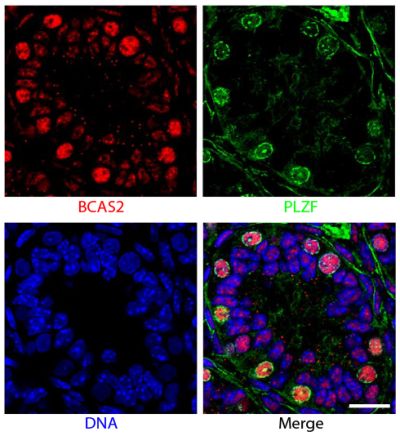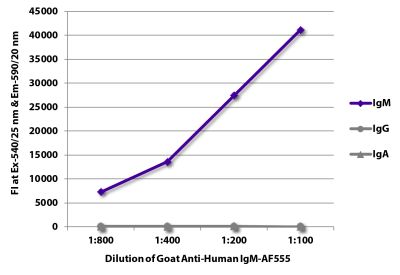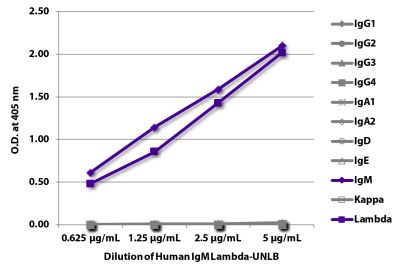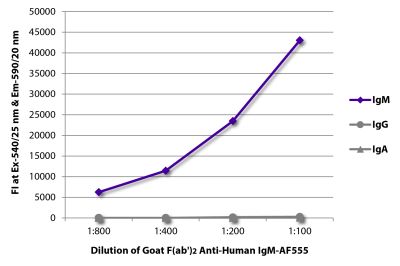Mouse Anti-Human IgM-AF555 (SA-DA4)
Cat. No.:
9020-32
Alexa Fluor® 555 Anti-Human IgM antibody for use in immunohistochemistry / immunocytochemistry and western blot assays.
$304.00
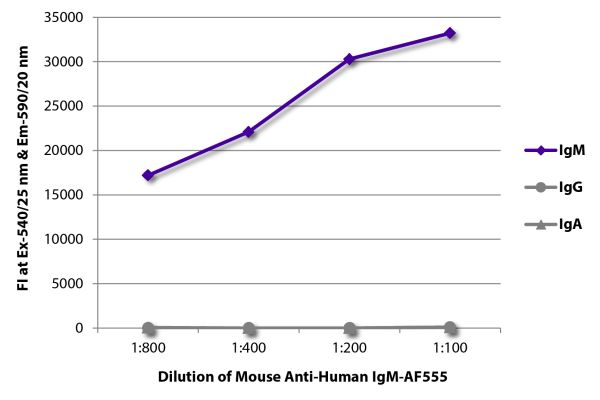

| Clone | SA-DA4 |
|---|---|
| Isotype | Mouse (BALB/c) IgG1κ |
| Isotype Control | 0102-32 |
| Specificity | Human IgM |
| Immunogen | Human IgM myeloma protein |
| Conjugate | AF555 (Alexa Fluor® 555) |
| Buffer Formulation | Phosphate buffered saline containing < 0.1% sodium azide |
| Clonality | Monoclonal |
| Concentration | 0.5 mg/mL |
| Volume | 0.2 mL |
| Recommended Storage | 2-8°C; Avoid exposure to light |
| Trademark Information | Alexa Fluor® is a registered trademark of Thermo Fisher Scientific, Inc. or its subsidiaries |
| Applications |
ELISA – Quality tested 2-7 FLISA – Quality tested Flow Cytometry – Quality tested 1,9,12-19 Immunohistochemistry-Frozen Sections – Reported in literature 12 Immunocytochemistry – Reported in literature 12 Immunoprecipitation – Reported in literature 1,8-10 Western Blot – Reported in literature 11 Multiplex – Reported in literature 3 Stimulation – Reported in literature 1,20 |
| RRID Number | AB_2796580 |
| Gene ID |
3507 (Human) |
| Gene ID Symbol |
IGHM (Human) |
| Gene ID Aliases | AGM1; MU; VH |
| UniProt ID |
P01871 (Human |
| UniProt Name |
IGHM_HUMAN (Human) |
Documentation
Certificate of Analysis Lookup
Enter the Catalog Number and Lot Number for the Certificate of Analysis you wish to view
- 1. Maruyama S, Kubagawa H, Cooper MD. Activation of human B cells and inhibition of their terminal differentiation by monoclonal anti-μ antibodies. J Immunol. 1985;135:192-9. (Immunogen, IP, FC, Stim)
- 2. Shaw DR, Khazaeli MB, LoBuglio AF. Mouse/human chimeric antibodies to a tumor-associated antigen: biologic activity of the four human IgG subclasses. J Natl Cancer Inst. 1988;80:1553-9. (ELISA)
- 3. Dasso J, Lee J, Bach H, Mage RG. A comparison of ELISA and flow microsphere-based assays for quantification of immunoglobulins. J Immunol Methods. 2002;263:23-33. (ELISA, Multiplex)
- 4. Wilson KM, Di Camillo C, Doughty L, Dax EM. Humoral immune response to primary rubella virus infection. Clin Vaccine Immunol. 2006;13:380-6. (ELISA)
- 5. Qian Y, Diaz LA, Ye J, Clarke SH. Dissecting the anti-desmoglein autoreactive B cell repertoire in pemphigus vulgaris patients. J Immunol. 2007;178:5982-90. (ELISA)
- 6. Xue L, Johnson R, Gorovits B. Prevalence and isotypic complexity of the anti-Chinese hamster ovary host cell protein antibodies in normal human serum. AAPS J. 2010;12:98-106. (ELISA)
- 7. Westra J, van Assen S, Wilting KR, Land J, Horst G, de Haan A, et al. Rituximab impairs immunoglobulin (Ig)M and IgG (subclass) responses after influenza vaccination in rheumatoid arthritis patients. Clin Exp Immunol. 2014;178:40-7. (ELISA)
- 8. Kiyotaki M, Cooper MD, Bertoli LF, Kearney JF, Kubagawa H. Monoclonal anti-Id antibodies react with varying proportions of human B lineage cells. J Immunol. 1987;138:4150-8. (IP)
- 9. Nakamura T, Kubagawa H, Cooper MD. Heterogeneity of immunoglobulin-associated molecules on human B cells identified by monoclonal antibodies. Proc Natl Acad Sci USA. 1992;89:8522-6. (IP, FC)
- 10. Wang Y, Nomura J, Faye-Petersen OM, Cooper MD. Surrogate light chain production during B cell differentiation: differential intracellular versus cell surface expression. J Immunol. 1998;161:1132-9. (IP)
- 11. Qu Z, Goldenberg DM, Cardillo TM, Shi V, Hansen HJ, Chang C. Bispecific anti-CD20/22 antibodies inhibit B-cell lymphoma proliferation by a unique mechanism of action. Blood. 2008;111:2211-9. (WB)
- 12. Chen K, Xu W, Wilson M, He B, Miller NW, Bengtén E, et al. Immunoglobulin D enhances immune surveillance by activating antimicrobial, proinflammatory and B cell-stimulating programs in basophils. Nat Immunol. 2009;10:889-98. (FC, IHC-FS, ICC)
- 13. Lassoued K, Illges H, Benlagha K, Cooper MD. Fate of surrogate light chains in B lineage cells. J Exp Med. 1996;183:421-9. (FC)
- 14. Sanz E, Alvarez-Mon M, Martinez-A C, de la Hera A. Human cord blood CD34+Pax-5+ B-cell progenitors: single-cell analyses of their gene expression profiles. Blood. 2003;101:3424-30. (FC)
- 15. Dryer RL, Covey LR. Use of chromatin immunoprecipitation (ChIP) to detect transcription factor binding to highly homologous promoters in chromatin isolated from unstimulated and activated primary human B cells. Biol Proced Online. 2006;8:44-54. (FC)
- 16. He B, Xu W, Santini PA, Polydorides AD, Chiu A, Estrella J, et al. Intestinal bacteria trigger T cell-independent immunoglobulin A2 class switching by inducing epithelial-cell secretion of the cytokine APRIL. Immunity. 2007;26:812-26. (FC)
- 17. He B, Santamaria R, Xu W, Cols M, Chen K, Puga I, et al. The transmembrane activator TACI triggers immunoglobulin class switching by activating B cells through the adaptor MyD88. Nat Immunol. 2010;11:836-45. (FC)
- 18. Szyszko EA, Brun JG, Skarstein K, Peck AB, Jonsson R, Brokstad KA. Phenotypic diversity of peripheral blood plasma cells in primary Sjögren's syndrome. Scand J Immunol. 2011;73:18-28. (FC)
- 19. Smith MJ, Packard TA, O'Neill SK, Dunand CJ, Huang M, Fitzgerald-Miller L, et al. Loss of anergic B cells in pre-diabetic and new onset T1D patients. Diabetes. 2014 Dec 18. pii: DB_131798. [Epub ahead of print]. (FC)
- 20. Preissler MT, Kaiser L, Drake JR, Gosselin EJ. Low-level signaling generated by FcγRIIB-B cell receptor co-ligation establishes a state of global B cell receptor nonresponsiveness. Immunol Invest. 2005;34:53-70. (Stim)
See All References


